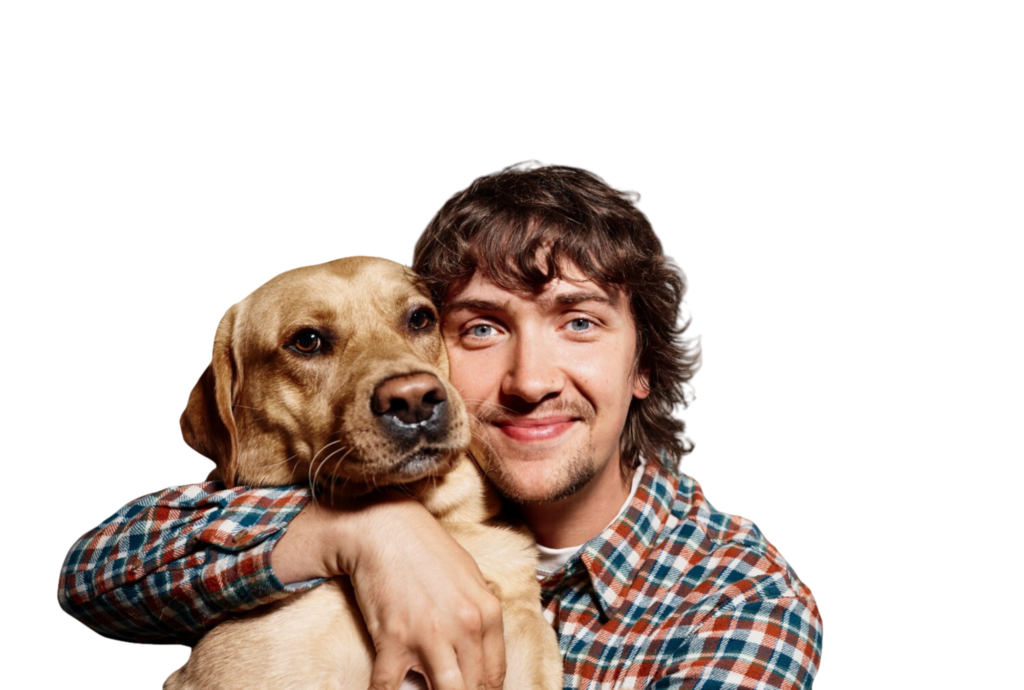When it comes to caring for your furry friend, understanding their coat type plays a vital role in keeping them healthy and happy. If you’ve heard about dogs with double coats but aren’t sure how to identify or care for one, this guide will walk you through everything you need to know.
In this comprehensive guide, we’ll walk you through the clear signs of a double coat, explore common double-coated dog breeds, and provide essential grooming tips for double-coated dogs to ensure their fur remains healthy and functional. Professional grooming service providers like Kontota provide a convenient, mobile dog grooming facility to help you manage your dog’s double coat with ease. From deshedding treatments to regular brushing and bathing, professional grooming ensures your pup remains comfortable and their coat stays in top condition.
What is a double coat?
A double coat is a form of fur that contains two separate layers:
- The Undercoat: This is the soft, thick layer that is closest to your dog’s skin. It keeps your dog warm in the winter and cool in the summer by acting as insulation.
- The outer coat (also called the guard coat): This is made up of longer, rougher hairs that keep your dog safe from dirt, wetness, and UV rays.
Double-coated dog breeds have this special mix of fur that makes them good for a wide range of weather and places.
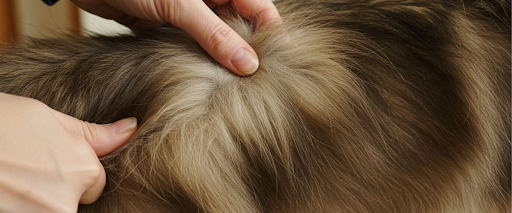
Signs Your Dog Has a Double Coat
Wondering how to tell if your dog has a double coat? Here are the most common signs:
- Soft, Plush Base Layer
Touch their fur with your fingers. Your dog might have a double coat if the hair near the skin feels thick and soft, but the hair on the exterior feels rough or coarse.
- Seasonal Shedding
Dogs with double coats lose a lot of hair twice a year, which is often called “blowing their coat.” This happens most of the time in the spring and fall when they change their undercoat to fit the weather.
- Visible Fur Layers
After brushing, you could see two quite different kinds of fur in the brush. The undercoat will look soft and fluffy, while the outer coat will feel rough or wiry.
- Breeds Known for Double Coats
Some breeds almost always have two coats. If your dog is a Husky, German Shepherd, Golden Retriever, Akita, Shiba Inu, or another breed, they probably have a double coat.
- Matting in Dense Fur
The thick undercoat might get tangled or matted if you don’t brush it regularly. This happens a lot in places where there is a lot of friction, such as the neck, behind the ears, and under the legs.
- Skin Irritation from Poor Ventilation
During the warmer months, an unkempt undercoat can block air from getting to the skin, which can cause discomfort or hot areas. Regular grooming helps keep the skin healthy and lets air flow, which stops these kinds of problems.
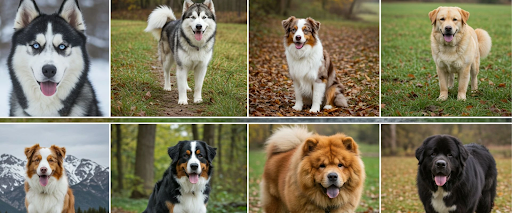
Double-Coated Dog Breeds
While we’ve already mentioned a few, here’s a quick list of common double-coated dog breeds:
- Siberian Husky
- Alaskan Malamute
- Labrador Retriever
- Border Collie
- Australian Shepherd
- Bernese Mountain Dog
- Chow Chow
- Newfoundland
If your dog’s breed is on this list, it’s highly likely they have a double coat!
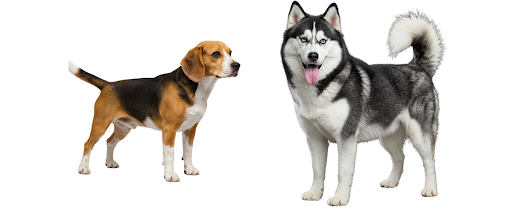
Why Grooming Double-Coated Dogs is Different
Proper grooming is essential for the health of double-coated dogs. Since their coats naturally regulate body temperature, maintaining the balance between the undercoat and outer coat is crucial. Here’s what to keep in mind:
1. Regular Brushing is Your Best Friend
This is the most important part of taking care of a double coat. Brushing your dog’s coat regularly gets rid of loose undercoat, stops matting, spreads natural oils, and keeps the skin and coat healthy.
Frequency: Aim for 2-3 times a week during non-shedding seasons. During seasonal “coat blows” (spring and autumn), daily brushing is highly recommended.
Tools:
- Undercoat Rake: You can’t do without this. The teeth are made to go through the topcoat and grab the loose, dead undercoat without hurting the guard hairs. Be careful with it and work in little parts.
- Slicker Brush: Great for removing tangles and surface debris and for general smoothing of the coat after raking.
- De-shedding Tools: Brands like Furminator can be effective, but use them sparingly and with caution to avoid damaging the topcoat or irritating the skin. Always follow the manufacturer’s instructions.
- Wide-toothed Comb: Useful for checking for any missed tangles or mats after brushing.
Technique: Always brush in the direction of hair growth. For areas with denser undercoat, you can gently part the fur and brush from the skin outwards, ensuring you reach the undercoat. Be thorough but gentle, especially around sensitive areas.
2. Bathing and Drying
You need to be particularly careful while bathing a double-coated dog to make sure both layers are clean and dry.
Frequency: Generally, bathing every 6-8 weeks, or when your dog gets particularly dirty or smelly, is sufficient. Over-bathing can strip natural oils.
Shampoo and Conditioner: Use a high-quality dog shampoo and conditioner specifically designed for shedding control or healthy skin and coat. Look for sulfate-free and paraben-free options.
Thorough Rinsing: This is crucial! Any shampoo or conditioner residue left in the thick coat can cause skin irritation. Rinse, rinse, and then rinse again until the water runs clear and the fur feels squeaky clean.
Thorough Drying: Never let a double-coated dog air dry completely. The dense undercoat traps moisture, which can lead to matting, skin infections (like hot spots), and a musty odor.
- Towel dry vigorously to remove as much water as possible.
- Use a high-velocity pet dryer (not a human hairdryer, which can be too hot). This is the most effective way to push out excess water and loose undercoat, ensuring the coat is dry down to the skin. Brush as you dry to help separate the hairs and prevent matting. If you don’t have a high-velocity dryer, ensure you use a cool or low-heat setting and brush constantly.
3. Trimming
Full-body shaving is a no-go, but some minimal trimming can be beneficial for hygiene and tidiness.
Hygienic Trims: Trimming hair around the paws, sanitary areas (under the tail and belly), and sometimes around the eyes can help prevent matting and keep your dog clean.
“Feathering” Trims: Some double-coated breeds have longer hair (feathering) on their legs or tail that can be lightly trimmed to maintain neatness and prevent tangles, as per breed standards.
Always Consult: If unsure, consult a professional groomer. They can advise on appropriate trimming for your specific breed and dog’s coat condition.
4. Professional Grooming
While home grooming is essential, professional grooming for double-coated dogs can make a huge difference, especially during heavy shedding seasons. Professional groomers have specialized tools and techniques to efficiently remove large amounts of dead undercoat, ensuring optimal coat health and reduced shedding in your home.
Beyond the Brush: Other Double-Coat Dog Care Tips
Grooming isn’t just about looks; it’s a way to support your dog’s health and comfort. Beyond brushing and bathing, here are additional tips:
A balanced diet rich in omega-3 and omega-6 fatty acids can contribute to healthy coat and skin, potentially reducing excessive shedding and improving coat quality.
A thick double coat can sometimes make it harder to spot fleas and ticks. Regular checks and consistent parasite prevention are crucial.
- Health Checks
Use grooming time as an opportunity to check for any lumps, bumps, skin irritations, or changes in your dog’s body.
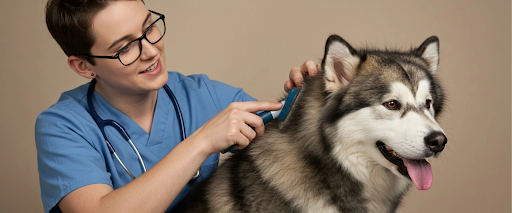
Give Your Double-Coated Dog the Care They Deserve
Understanding how to tell if your dog has a double coat is the first step to ensuring proper care. Whether it’s selecting the right grooming tools or booking professional services, keeping your pup’s coat healthy will keep them happy and thriving.
At Kontota, we specialize in grooming double-coated dogs. Our mobile grooming vans bring salon-quality care to your door, making grooming stress-free for you and your pet. Contact us today to schedule an appointment or learn more about our services. Your furry friend deserves nothing but the best!
FAQs About Double-Coated Dogs
Q1. Do all dogs have double coats?
No, not all dogs have double coats. Some breeds have single coats, which lack the dense undercoat layer. Single-coated breeds include Poodles, Greyhounds, Maltese, and Boxers.
Q2. Can I shave my dog’s double coat during the summer?
No, shaving a double coat is not recommended. It can interfere with their natural temperature regulation and leave them vulnerable to sunburn and skin damage.
Q3. How often should I groom my double-coated dog?
Regular brushing (2-3 times weekly) and seasonal deep grooming during shedding periods are key. Professional grooming every 6-8 weeks can also help maintain their coat’s health.
Q4. Are double-coated dogs hypoallergenic?
No, double-coated dogs are not hypoallergenic. Their shedding and dander can trigger allergies in sensitive individuals.



